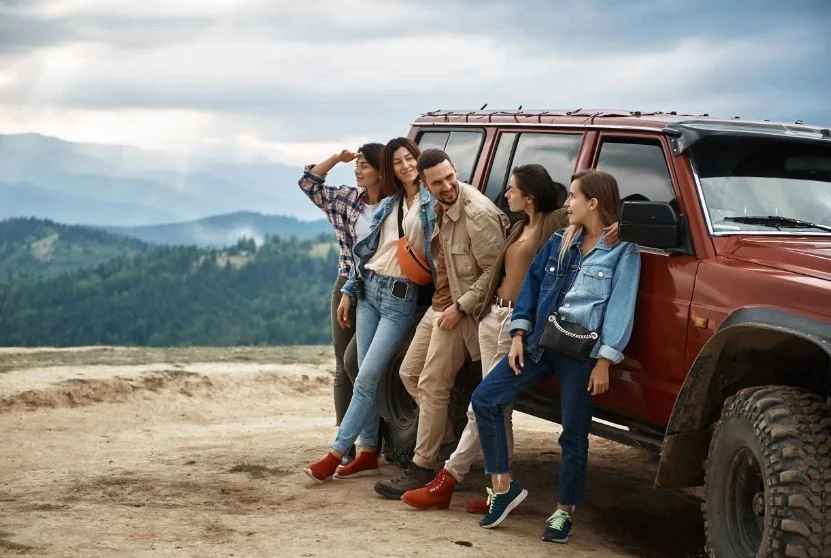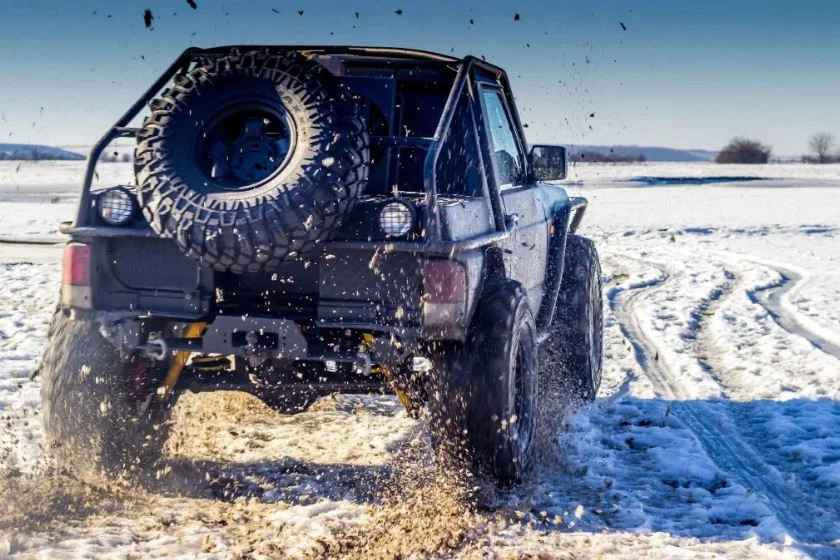7 Awesome Tips To Prepare Your Off-Road Vehicle

Off-roading can be an amazing experience, but you must be properly prepared before hitting the trails. This means having the right gear and equipment and understanding your vehicle’s capabilities and limitations. This article will cover seven tips to help you prepare your off-road vehicle for your next adventure.
Tips to Prepare Your Off-Road Vehicle
1. Know Your Vehicle’s Limits and Terrain
When driving off-road, it’s crucial to know the limits of your off-highway vehicle and the terrain you’ll be driving on. Understanding your vehicle’s capabilities and size can help you navigate difficult landscapes, steep inclines, or obstacles with greater ease.
It’s also important to take note of clearance and approach angles so you don’t find yourself stuck or bottoming out on a rock or tree stump.
Additionally, familiarising yourself with the terrain—mud, sand, gravel, or a rocky path—can give you valuable insight into what kind of tires to use and how to adjust your driving style accordingly.
By learning and respecting these limits and factors that contribute to off-road travel, you’ll increase your chances of having a fun and safe trip in the great outdoors.
2. Inspect Tires, Suspension, and Brakes
When heading off-road, it’s essential to ensure your vehicle is in tip-top shape, including being examined by an expert and inspecting your tires, suspension, and brakes before you hit the terrain.
Tires should be examined for any signs of damage or wear and tear, as these could spell disaster on rugged trails.
It’s also vital to ensure they’re properly inflated according to manufacturer recommendations.
Ensuring that you also have a spare tire. A thorough suspension check will help you identify worn-out shocks or broken springs that may make the ride dangerous or uncomfortable.
Lastly, a complete brake inspection guarantees optimal stopping power when navigating steep inclines or tricky descents.
Paying attention to these details might seem like a lot of work upfront, but it will save you from potential troubles that can ruin your off-road experience down the road.
3. Install Protective Gear For the Engine And Body
If you want to take your off-road vehicles, it’s essential to take some protective measures. Installing protective gear for the engine and body can help prevent damage from rocks, debris, and other hazards on the trail. Some popular options include skid plates, rock sliders, and protective bumpers.
Skid plates are designed to protect the underside of your vehicle from rocks and other objects that could potentially damage vital components like the oil pan or transmission. Rock sliders provide added protection to your vehicle’s sides by creating a barrier between potential obstacles and your doors or fenders.
Protective bumpers offer an additional layer of protection at the front and rear of your vehicle to help deflect anything that might come into contact with it.
Investing in proper protective gear will make your off-roading adventures safer and more enjoyable.
4. Protective Gear Checklist:
Off-roading requires much preparation, including ensuring you have the appropriate protective gear.
A good protective gear checklist should include a helmet, gloves, a durable jacket, pants, boots, and goggles or sunglasses.
Properly fitting gear is crucial to ensure that it will provide optimal protection during potential falls or spills.
The helmet is arguably the most important protective gear as it protects your head from serious injuries in accidents.
Gloves should be durable and offer proper grips, while the jacket should be abrasion-resistant for extra protection against scrapes and bruises.
You can also choose pants with padding on the knees and hips to minimize your chances of getting hurt if you take an unexpected tumble.
Above all else, prioritize quality over style when selecting off-road protective wear, as staying safe is paramount when exploring new territories!
4. Pack Emergency Supplies And Tools
When heading out off-roading, packing emergency supplies and tools is essential to ensure a safe and enjoyable trip. A first-aid kit should be at the top of your list, complete with bandages, gauze, antiseptic wipes, and pain relievers.
Also, packing spare tires and lug wrenches, jacks, tire patches, or plugs can help you tackle any unforeseen blowouts or punctures.
Remember to pack a fire extinguisher in case of vehicle fires or wildfires. A multi-tool kit with pliers and screwdrivers can also be useful for minor repairs.
Finally, bring plenty of water and food with you just in case challenges arise, causing unexpected delays to your trip, because it’s always better to be over-prepared than underprepared when venturing off-road!
No matter how well-planned a trip is, unforeseen circumstances always arise when one least expects them; that’s why packing emergency supplies is essential before heading out into the wilderness for off-roading.
Some necessary supplies include:
– First aid kit
– Tire repair kit
– Jumper cables
– Tool kit
– Extra fuel & oil
Emergency Supplies Checklist:
- Tire repair tools
- Jumper cables
- Air compressor
- Spare fluids (oil/coolant)
- Ratchet straps & tow rope
5. Plan For Communication And Navigation
When it comes to off-road adventures, a plan for communication and navigation is crucial to ensure you stay safe and have a successful trip.
First, you should invest in top-quality equipment, including handheld radios or cell phone communication devices.
Off-roaders need to be able to notify others if anything goes wrong or if the group splits up. Regarding navigation, maps are an essential tool, and GPS technology can help pinpoint your location even in the most remote terrain.
Always review the route and ensure everyone has a copy of the map before setting out on your adventure.
Finally, ensure someone knows your intended route and expected return time so they can notify authorities if necessary. With these tools in place, you’ll be prepared for anything that comes your way when trail driving.
Communication & Navigation Checklist:
- Two-way radios/walkie-talkies
- GPS unit with offline maps
- Paper maps as backup
6. Follow Safety Guidelines And Practice Responsible Off-Roading
Regarding off-roading, following safety guidelines and practices is crucial to ensure your safety and that of others. Always wear the proper gear, including a helmet and protective clothing, and never ride above your skill level.
Ensure you have a reliable vehicle and keep it in good condition before hitting the trails. Before starting your ride, familiarise yourself with the area’s regulations, stay on designated paths, and be aware of potential hazards or obstacles.
Additionally, always ride with others for added safety and support. Following these common-sense guidelines and being cautious while enjoying the thrill of off-roading can help prevent accidents and ensure everyone has a fun and safe experience.
Adopting responsible practices like:
– Carrying all trash back home
– Helping preserve nature’s beauty
– Respecting other trail users’ space
7. Plan For Your Off-Road Adventure
When planning an off-road adventure, it’s important to plan for your safety and enjoyment. First and foremost, bring adequate supplies like water, food, a sleeping bag, a first-aid kit, and emergency tools such as a spare tire and winch.
Always research the area where you’ll be driving beforehand – knowing the terrain and weather conditions can help you pack accordingly.
Additionally, telling someone about your plans in an emergency is wise. Lastly, take care of yourself while on the trail by staying hydrated, wearing appropriate clothing, and protecting against sunburns.
With these simple tips in mind, you can ensure that your next off-roading experience is safe and memorable for all the right reasons!
Proper planning alleviates the chances of unforeseen events; therefore, setting up one’s itinerary before going out saves one from extra expenses accrued when trying to remedy situations that could have been avoided.
Pre-planning entails:
- Selecting appropriate time based on weather patterns
- Filling up gas tanks before heading out
- Check for a flat tire
- Ensuring a recovery kit

What accessories should I consider adding to my off-road vehicle?
There are a few 4×4 accessories worth considering. A sturdy winch can save the day if you get stuck in a tricky spot, and a set of high-quality recovery straps will help you get back on track.
Consider installing rock sliders or skid plates to protect your vehicle from scrapes and scratches. A good set of all-terrain tires is essential for tackling uneven terrain, while a lift kit can give your vehicle some extra clearance.
If you plan on driving at night, investing in additional lighting options like LED light bars can greatly improve visibility. Finally, remember creature comforts – add comfortable seats and enough storage space to make long trips more enjoyable. These accessories will enhance your off-road experience and increase trail safety and reliability.
How do I properly maintain the tires on my off-road vehicle?
One of the most important aspects of maintaining your vehicle is properly maintaining the tires. Firstly, check the tire pressure regularly and keep it at the recommended levels according to the manufacturer’s guidelines. Check for any visible damage or punctures and replace them as necessary.
Keep an eye on your tread depth – this can be quickly done by inserting a penny into the tread grooves, and if you can see Lincoln’s head fully, then it’s time to replace your tires. Additionally, inspect your tires for any uneven wear patterns that could indicate alignment or suspension issues.
Finally, before heading on any particularly rough terrain, consider deflating your tires slightly for more grip and traction. Remember to reinflate them after returning to regular roads, as driving on underinflated tires can damage them over time.
Are there any legal requirements or permits for driving an off-road vehicle on public land?
It’s essential to familiarise yourself with the regulations surrounding permits. First, ensure you have a valid driver’s license and registration for the vehicle.
Next, research where you plan to ride, as some areas may require specific permits or have designated trails.
In addition, areas such as national parks may restrict off-road driving altogether. Remember that permits aren’t just about following rules; they help ensure safety and protect natural resources by controlling where vehicles can go.
Obtaining permits is often straightforward, but failure to do so can result in hefty fines and penalties that could ruin your outdoor adventure experience. So take permit requirements seriously – they help keep public lands open and enjoyable for everyone!
Final Words
In conclusion, preparing an off-road vehicle involves more than just hopping into one car and hitting dirt roads aimlessly; ensuring readiness requires taking calculated steps like inspecting tires for wear-and-tear, packing emergency supplies, practicing responsible riding etiquette, amongst other aforementioned items leading towards an enjoyable experience devoid of regrets after returning home exhausted yet fulfilled by nature’s grandeur offered during the adventure.
Also Read: Best Places to Visit in Myanmar
Follow Top and Trending on Google News and receive the latest alerts and the main news about apps, technology, beauty, entertainment, and all the top 10 related posts.
